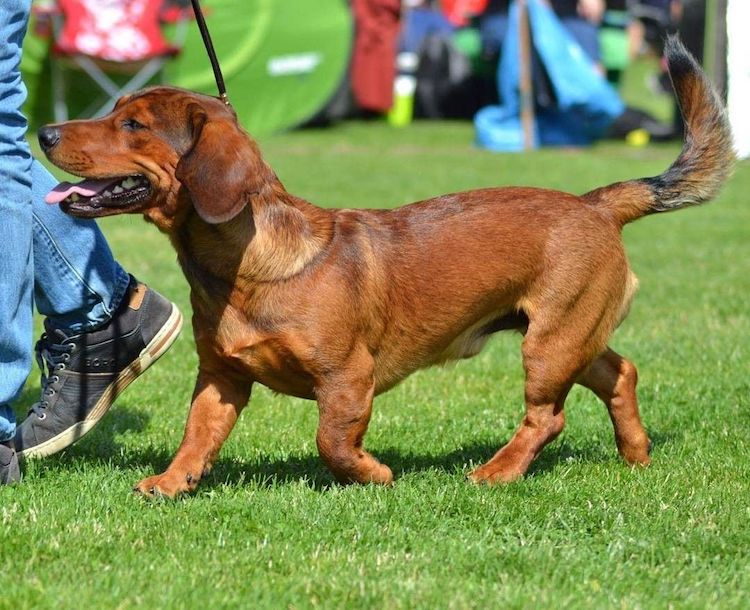The Alpine Dachsbracke is a scent hound breed from Austria, Europe. This is a small to medium size dog breed, originally developed to track wounded game animals such as Deer, Boar, Hares and Fox. This dog resembles a Dachshund, but with longer legs. It is a sturdy, strong dog with big bones. They are friendly and amiable, and do well with children and other dogs.

Alpine Dachsbracke Temperament
This is primarily a hunting dog, and is mostly kept by hunters and forestry workers. They have a friendly personality, and get on well with children and other dogs. They have an extremely well-developed sense of smell, even for a dog, and will tend to follow any interesting scents.
These dogs have a high prey drive, and should not be left alone with other small pets in the home such as rabbits or guinea pigs. If they have all been brought up together from the dog being a puppy, things may be less dangerous!
The Alpine Dachsbracke was breed to be able to complete a full day’s hunting, and so they have a lot of energy and endurance. They need exercise every day, such as a good long walk, and also a large fenced back yard where they can enjoy running around after a ball.

Alpine Dachsbracke Breed History
The Alpine Dachsbracke is thought to date back to ancient times, but there is no solid evidence. The documented history of this breed dates back to the 1800’s, when they became a part of Crown Prince Rudolf of Habsburg’s hunting dog kennel in between 1881 and 1885. They were bred down in size by crossing larger hunting dogs with Dachshunds.
There is a story that only people inside the royal court were allowed to own an Alpine Dachsbracke, until the early 1900s. The Crown Prince used the Alpine Dachsbracke to follow the scent of wounded game animals, mainly deer, rabbit and fox, through thick underbrush.
The Alpine Dachsbracke was very good at tracking over rough land where other longer legged, larger scent hounds had difficulty. The breed is most famous for being part of Crown Prince Rudolf’s hunting expeditions in Turkey and Egypt.
This breed has been depicted in paintings and photographs with the royal while on these hunting excursions. In 1932, canine organizations and registries within Austria recognized the Alpine Dachsbracke as the third scent hound breed.
At that time the breed was called the Alpine-Erzebrigs – Dachsbracke. Then in 1975, the Federation Cynologique Internationale officially declared the country of origin as Austria and renamed the breed the Alpenländische Dachsbracke.
The FCI then moved the Alpenländische Dachsbracke into Section 2 of its scent hound group in 1991, and at the same time renamed the breed to the Alpine Dachsbracke. The United Kennel Club is the only English speaking kennel club to officially recognize the Alpine Dachsbracke.

Ease of Training
This not a difficult breed of dog to train. They are intelligent, and quickly pick up the idea of learning something new. If they are not handled correctly, they may seem to be obstinate, but this is usually down to the owners lack of dog training knowledge.
I recommend starting with puppy training classes, to introduce your dog to other dogs, new sights, smells and sounds. After the age of 12 months, one-on-one training with a professional dog trainer will give you amazing results. The dog will learn what is expected, and you will learn how to continue the training.
Grooming
The Alpine Dachsbracke has a short, dense coat which does not need much grooming. A weekly rub down with a soft brush or hound glove is enough to keep the dog’s coat shining.
They only need occasional bathing when they get a doggy odor or particularly muddy. The ears should be checked for foreign objects and signs of infection such as redness, swelling or a bad smell.
The dog’s teeth should be brushed each day with a dog-specific toothpaste – not a human toothpaste. And use a small, soft brush in a gentle circular motion, to massage the gums.
Vital Statistics
Height; 13 inches to 16 inches.
Weight; 30 lbs – 40 lbs
Lifespan; 11 to 13 years
Colors; Black, Red, Russet. May have a white patch on the chest.

Protection
The Alpine Dachsbracke breed is friendly and welcoming towards strangers, and will not bark when unknown people approach the house. They love meeting people, and will usually greet newcomers with enthusiasm.
This means that they are not good watch dogs, nor guard dogs. They are simply too friendly, and lack the physical size to intimidate anyone. If you are looking for some extra protection, look for a different breed.

Health Considerations
As an active hunting breed with a long history, this is a healthy dog with few health problems. Responsible breeders will screen their stock for back problems and patellar issues. They may also suffer from ear problems, as they hunt through low scrub and bush lands.



